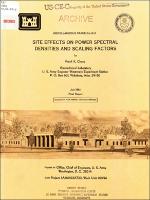Please use this identifier to cite or link to this item:
https://hdl.handle.net/11681/10343| Title: | Site effects on power spectral densities and scaling factors |
| Authors: | Chang, Frank K. |
| Keywords: | Accelerograms Spectrum analysis Earthquake engineering Earthquakes Statistical analysis Power spectra Spectrum analysis |
| Publisher: | Geotechnical Laboratory (U.S.) Engineer Research and Development Center (U.S.) |
| Series/Report no.: | Miscellaneous paper (U.S. Army Engineer Waterways Experiment Station) ; GL-81-2. |
| Description: | Miscellaneous Paper Abstract: This study presents the results of a statistical analysis of the spectral shapes of power spectral density (PSD) functions, G(ω) , in the 0.006- to 10-Hz range for 421 horizontal ground accelerograms (all records processed to the same duration of 163.83 sec, i.e., 1/163.82 = 0.006 Hz) from 89 earthquakes, mostly in the western United States and Japan. The analysis shows clear differences in spectral shapes for different soil and geological conditions. Within the high-frequency range of 2.5 to 10 Hz, the spectrum for the rock sites contains the highest energy or intensity; the spectrum of the stiff soil sites is slightly less than for the rock sites; and the spectra of the soft clay and sand sites and the deep cohesionless soil sites are almost the same and are lower than those for stiff soils. However, in the low- frequency range of 0.006 to 2.5 Hz, the reverse exists : the soft sites indicate the highest energy, the deep cohesionless soil sites are next, the stiff soil sites are third, and finally, the rock sites. A qualitative comparison was made of the spectral shapes of the PSD calculated in this study with the acceleration response spectra (ARS) of Kiremidjian and Shah (1978), Seed and Idriss (1971), and Seed, Ugas, and Lysmer (1976). There is general agreement in the shapes of both types of spectra, except the relative amplitudes for the rock sites for the ARS were less than those of the PSD in the high- frequency range. The difference in relative amplitudes for the rock PSD and ARS is due principally to the lesser number of records used in the data analysis for the latter. The number of records for the rock sites was 28 for the ARS and 56 for the PSD. Another difference is that the spectral shapes of PSD functions show more peaks than do the ARS, i.e., ARS are smoother. Above all, both differences could be affected by the frequency increment and the smoothing technique. The average and average plus one standard deviation power density spectra functions for different site conditions have been normalized to a unit area. Based on these normalized PSD standard spectra and amplification scaling curves, which are derived from the average power λ², the area under G(ω), or its square root, the rms (root-mean-square) value (λ) developed in this study, a design earthquake PSD spectrum for any earthquake magnitude and distance can be generated. These scaling curves, i.e., the correlation curves of peak ground acceleration or peak velocity versus rms value, and rms value versus Modified Mercalli Intensity, can also serve as earthquake engineering intensity scales in a quantitative manner. |
| Rights: | Approved for public release; distribution is unlimited. |
| URI: | http://hdl.handle.net/11681/10343 |
| Appears in Collections: | Miscellaneous Paper |
Files in This Item:
| File | Description | Size | Format | |
|---|---|---|---|---|
| MP GL-81-2.pdf | 2.94 MB | Adobe PDF |  View/Open |